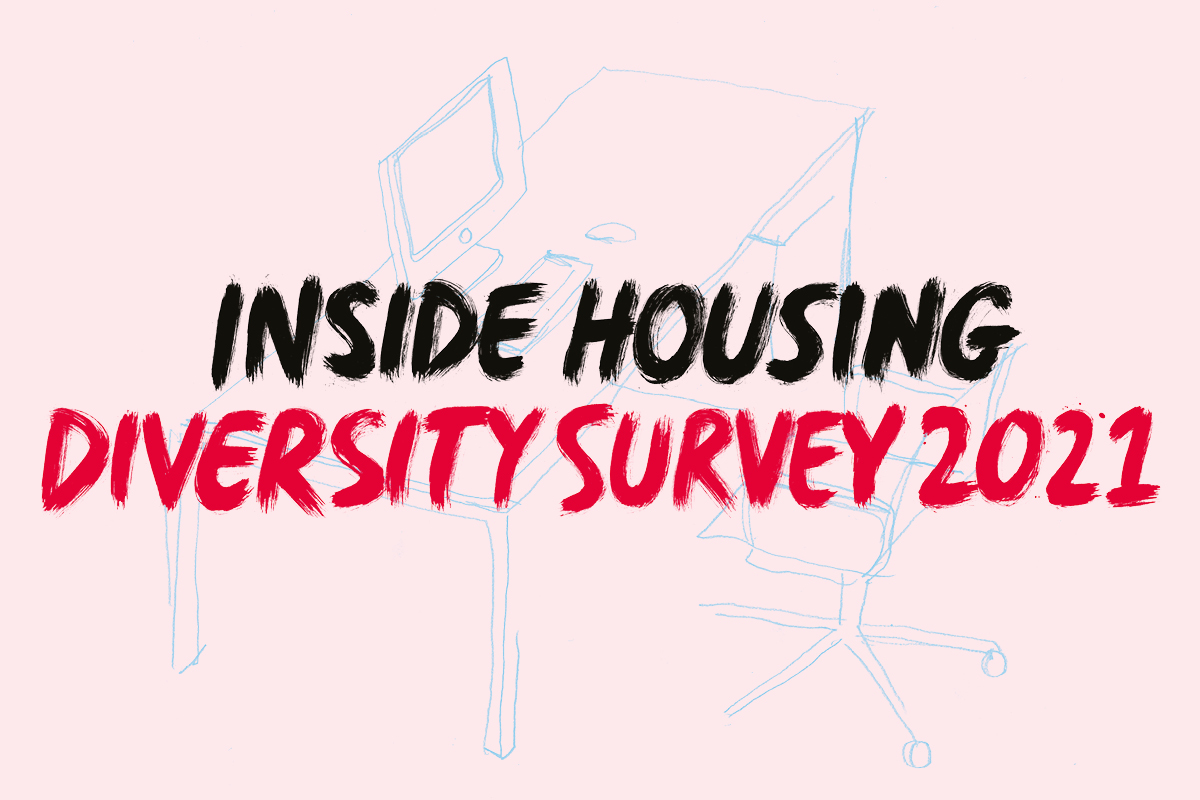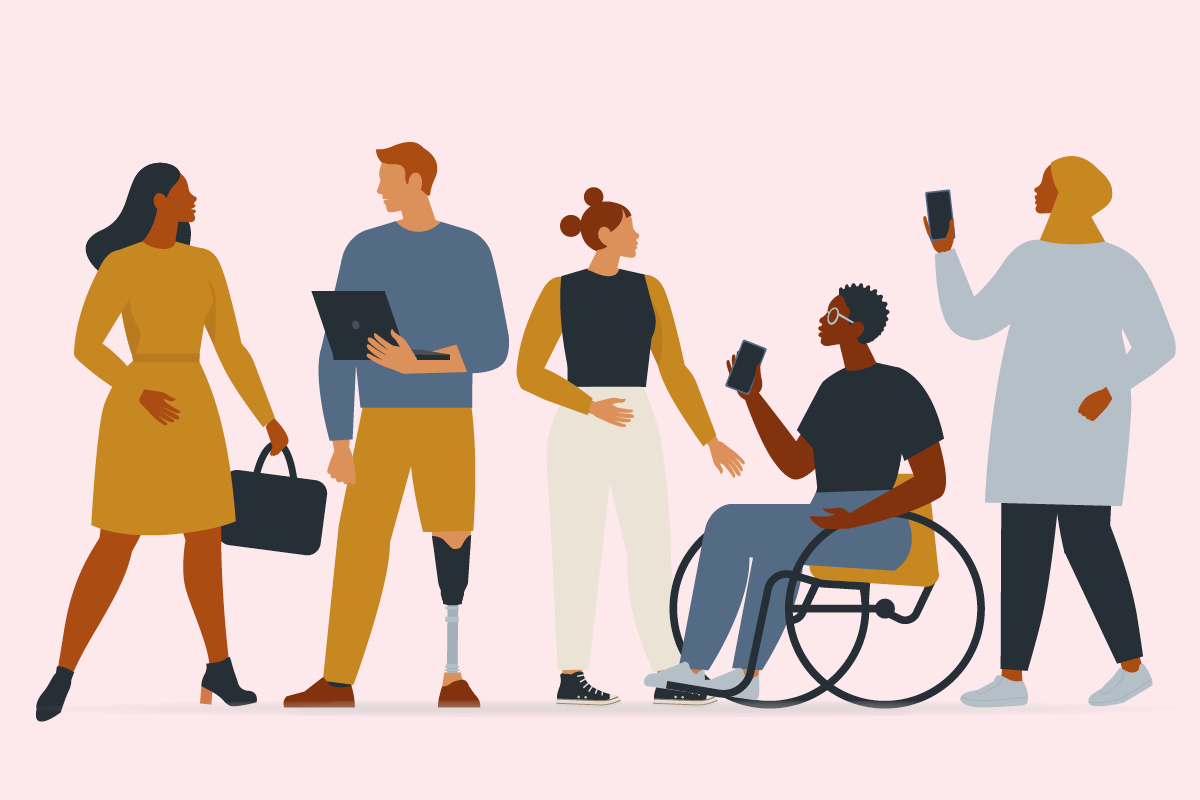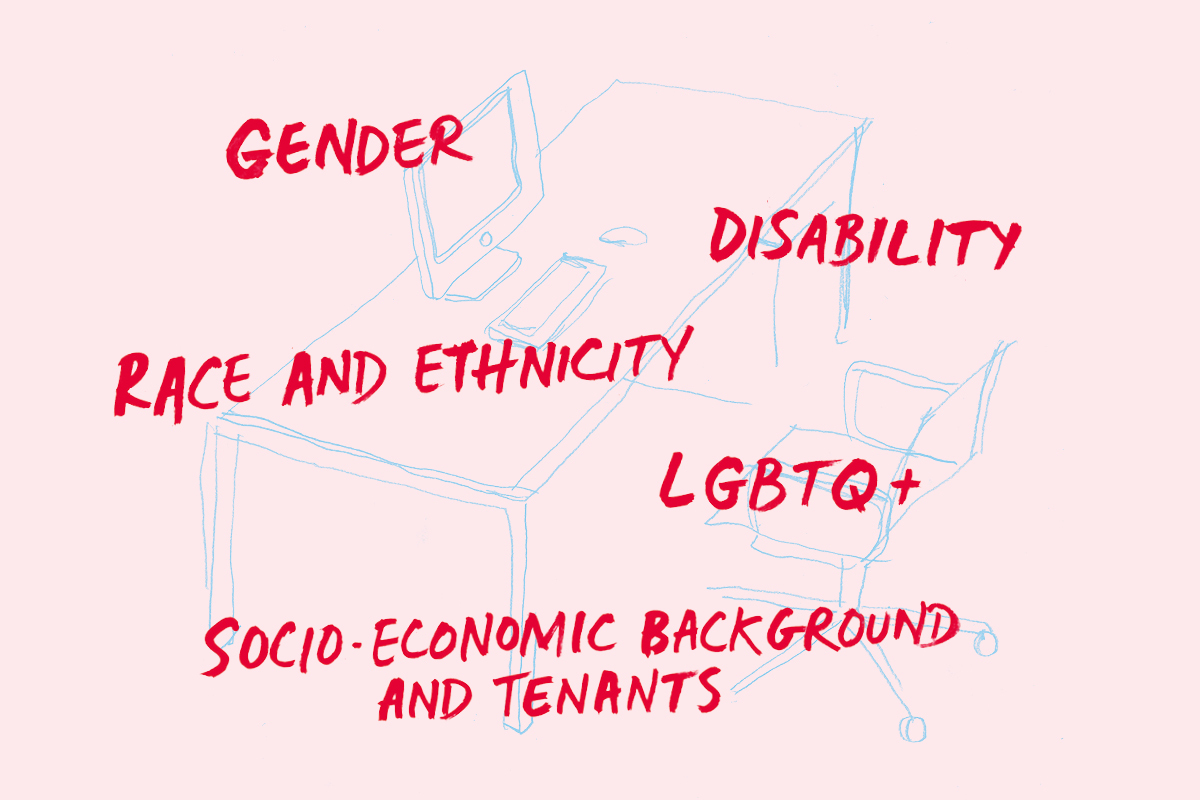You are viewing 1 of your 1 free articles
Inside Housing diversity survey 2021: we reveal how diverse UK housing’s leadership is
How diverse is housing’s leadership? Our survey of 101 landlords reveals the answers. Illustrations by Ben Tallon
This year, Inside Housing has relaunched its diversity survey, to provide new and better data on who holds the top jobs in housing. We have tried to answer the questions: who are the sector’s board members? Who is on executive teams? How representative and diverse are the people who occupy these top housing jobs?
We have relaunched this data-gathering exercise with new questions. We think these questions are better, and will tell us a lot more than we knew already about the sector. We worked to make some of the questions the same or similar to the National Housing Federation’s diversity tool, knowing that many associations are also gathering data for this exercise, and we will be highlighting this important work later this year.
Unfortunately, data constraints mean it is hard to make the survey truly intersectional – we can tell you how many women are executives, but not how many of them are women of colour. We can tell you how over-represented men are at board level, but not how many of the tenants on boards are men.
As you will see in the pages that follow, the level of data held – or at least shared – is very variable. Still, we believe that the survey can hold a mirror up to the housing sector’s leadership and say: where are we now? Are we diverse enough?
What you will learn from this article is that, while progress has occurred in pockets, there is no area of equalities in which we can say that the sector’s top jobs are truly diverse enough or reflective of society.
It is significant that out of 138 housing associations approached to take part, we were able to gather responses from only 101.
The organisations that did respond told us details about 1,186 board members and 558 executives.
The people Inside Housing spoke to for this story believe that diversity of senior roles matters. Serena Jones, executive director of operations at Coastal Housing in Wales, says: “There’s nothing like having diverse networks, personally and professionally, with all the valuable insights those life experiences bring. It can only benefit residents if we’ve got more diverse workforces.”
The benefits come in many forms, and cultural competency of staff and leadership is a huge piece of this. How will your staff and organisation handle, to give just one example, a trans tenant wanting to change their records to reflect their gender identity?
“There’s nothing like having diverse networks, personally and professionally, with all the valuable insights those life experiences bring. It can only benefit residents if we’ve got more diverse workforces”
Meanwhile, research has consistently shown that diverse boards and leadership teams make better decisions. McKinsey, which has studied the impact of diversity on corporate profitability worldwide, found that the companies in the top quartile for gender diversity on executive teams were 25% more likely to have above-average profitability, compared to those in the bottom quartile.
It found that the greater the representation of women, the more likely a company was to be profitable. For ethnic diversity, the results are even more compelling, with the top quartile of most diverse executive teams outperforming the least diverse by 36%.
Jitinder Takhar, chief executive of Homes for Lambeth and a member of Inside Housing’s race and housing editorial panel, notes: “I’m proud of the fact that our executive team is both gender and ethnically diverse, with 75% from a BME background and 75% female. This has a noticeable and positive impact on staff who can recognise themselves in our make-up and hopefully also has the same impact with the communities with whom we work.”
Lack of diversity can also be a sign of problems. Are your Black, Asian and ethnic minority staff being promoted, or are they – as Inside Housing uncovered last year in an investigation – leaving the sector because their talents are not being recognised?
Consultant Davina Boakye said at that time: “If you are unable to attract quality candidates to your boards or senior management teams, there’s a reason for that. If we are reluctant to come, it’s because you’ve made it almost impossible for us to get in. Giving myself a headache knocking against doors that don’t want to open isn’t what I want to spend my life doing.”
Is your organisation, and housing as a whole, somewhere that talent is recognised and prompted – or is it a knocking-against-doors organisation?
Read on to find out more.
Race and ethnicity
62
Number of associations with all-white executive teams. Four provided no information on ethnicity of executives
94%
Percentage of executives working for Scottish associations who are white, or 33 out of 35 individuals
1
Number of white Gypsy people at board or executive level across 101 organisations
25
Number of associations that told us they have all-white boards, out of 101
In the wake of Black Lives Matter, many social landlords have renewed their commitment to tackling race inequality in their own organisations, and said that they are working towards being anti-racist organisations. Many committed to look at representation of ethnic minorities in senior roles as part of this, as well as examining why Black, Asian and minority ethnic people are being under-promoted in the sector.
“The change will be incremental. I fully expect to be focusing on this for the rest of my career, [and] I’ve got 28 years before I retire”
Our survey shows that there is still a long way to go. Our last diversity survey was in 2019, and found that 9.1% of executives and 13.6% of board members were Black, Asian or minority ethnic. We changed the questions this year, to ask landlords for a breakdown of ethnicity in much more detail – mirroring census questions – which allows us to tell you much more about what is going on in the boardrooms and executive suites of housing associations.
The numbers are not really comparable for this reason – the category ‘Black, Asian and minority ethnic’, for example, can include white ethnic minorities. However, we can see that, for example, more than 90% of executives from those associations that responded are white, and 87.4% of board members.
Olu Olanrewaju, chair of Leadership 2025, a charity working to make the housing sector more diverse, and a member of Inside Housing’s race and housing editorial panel, sums up: “Material change in terms of representation has not happened. [The survey results] continue to make the case for why change is necessary, and it’s not happening fast enough.”
Looking at what is happening in London is particularly instructive, because London is one of the most ethnically diverse parts of the UK, with about 40% of the population being Black, Asian and minority ethnic when the 2011 census was taken.
London is also the headquarters for the G15 group, which includes some of the largest landlords in the UK. The G15 has set out its stall on diversity in senior roles, for example setting a target for 30% of board members to be BME by 2025.
However, the data from our survey shows a decidedly mixed bag. Two landlords – Clarion and Southern – refused to provide figures. Hyde responded, but did not provide any answers to our questions on race and ethnicity of its board members, only its executive team, which it told us is made up of only white people.
“Material change in terms of representation has not happened. [The survey results] continue to make the case for why change is necessary, and it’s not happening fast enough”
Clarion said information on diversity can be found in its annual report. The report says that one in five of its staff are from Black, Asian and minority ethnic backgrounds – but it does not discuss representation at executive or board level. It does discuss gender equality, stating that the executive team is evenly split between men and women.
The data on the remaining landlords shows that only 17% of G15 board members are people of colour, and 83% of G15 executive team members are white. Only four executives are Black, and another four Asian.
These figures relate only to organisations which responded to our survey. The totals across the G15 are described in more detail here, with 20% of board members from an ethnic minority background.
Jamie Ratcliff, executive director of people and partnerships at Network Homes, who has been working within the G15 group of London landlords on the issue of diversity, says: “The clear line that the G15 [has taken] is the area that needed the most attention is people from ethnic minority backgrounds [in senior roles].”
Mr Ratcliff says that the numbers show that as a group, the G15 is on track. He says that change for board members – who typically have six-year maximum terms – can be achieved quicker than at executive level. “The change will be incremental. I fully expect to be focusing on this for the rest of my career, [and] I’ve got 28 years before I retire,” he adds.
Wales and Scotland have significantly less ethnic diversity at board and executive level.
In some ways this is perhaps to be expected, as both countries have less diverse populations, (94.8% and 96% white respectively), but it still does point to an issue. Glasgow has the most ethnic diversity in Scotland, being 12% ethnic minorities in 2011, the latest year for which there is data. But Wheatley Group, which is based in the city, has only white people at board and executive level.
A Wheatley spokesperson says: “We are absolutely committed to increasing and improving diversity in all parts of the group, and that includes our executive team and all boards and departments. It is a major element and focus of the independent governance review that is set to be considered by the Wheatley board.”
Mr Olanrewaju from Leadership 2025 notes that many organisations are now realising that diversity at decision-making level simply makes for better decisions. With this in mind, he says: “All the evidence is you make better decisions, [so] why are you not doing what’s right for your business?”
Gender
41
Percentage of board members who are women
31
Associations with only one woman at executive level. Four have only one woman at board level
34
Proportion of women on executive teams of G15 organisations
60%
Proportion of women on executive teams of Scottish associations
0
Number of board members who are non-binary
3
Number of executive teams that are all-male. No boards are all-male
1
Number of executives who are non-binary
4
All-female executive teams
42
Percentage of executives who are women
When Inside Housing did our first ever diversity survey in 2016, four in 10 board members and executives were women. The figures today have barely changed – 41% of board members and 42% of executive team members are women. Out of 1,744 senior leaders, only one identified as non-binary.
In other words, men are still over-represented in top housing jobs, and the needle has barely shifted. That said, there have been changes. Five years ago, seven associations told us they had all-male executive teams. Now that applies to three – PA Housing, Red Kite and Acis. Back then, only 23% of associations had at least 50:50 men and women; now the figure is 39 out of 101.
Men’s representation in executive teams
58%
UK-wide executives
66%
G15 executives
54%
Wales executives
40%
Scotland executives
Dilip Kavi, chief executive at PA Housing, says: “We have been very aware that we have an all-male, four-strong executive team. That’s why we introduced a new leadership structure, with 10 assistant director level positions having been created. This has not only enabled us to promote a diverse group of talented individuals to a highly senior level – it also means we will be able to make our succession planning ambitions a reality.”
The picture on men’s over-representation in top jobs is dramatically different, though, in different parts of the sector. While in Scotland, women make up the majority of executive teams, in the G15 women make up only a third of those top jobs.
Welsh associations have many more women in leadership jobs than the sector as a whole – of the five Welsh associations to respond, all have female chief executives, and 46% of executives are women.
Executive teams made up of one gender
All-male executive teams
- Acis
- PA Housing
- Red Kite Association
All-female executive teams
- First Choice Homes Oldham
- Irwell Valley Homes
- Gateway Housing
- Salix Homes
Of the Scottish associations that responded, only 34% of board members are women – but 60% of those in executive leadership roles are women.
Moira Bayne, chief executive of charity Housing Options, and who has worked across different parts of the Scottish sector, says this is no accident and could be down to greater reliance on internal promotion in Scotland: “A lot of recruitment at social landlords has been from the bottom up – starting at a junior level.”
LGBTQ+
30
Number of board members (2.6%) who identify as lesbian or gay
0
Number of trans people at executive or board level across the sector
29
Number of executives who identify as lesbian or gay, out of 553
4
Number of board members, out of 1,186, who identify as bisexual. Two identify as other sexualities
34
Percentage of board members for whom there is no data held on sexuality. For executive teams this is 20%
0
Number of executives who identify as bisexual or other sexualities
When it comes to LGBTQ+ representation in senior jobs, one key finding is that there is no representation of trans people at the most senior level in the sector. At least as far as survey responses from our 101 associations goes, none of the board members or executives identify as trans.
“Zero trans people is not a surprise. It’s really sad but indicative of where we are,” says Jon Foster, director of service development at Metropolitan Thames Valley. “We have few gender-diverse people in any senior position even before you get to exec [level].”
This could be a result of trans staff not being willing to share this information with their associations.
However, Serena Jones, executive director of operations at Coastal Housing in Wales, notes: “I don’t think I’ve ever known an out trans-identified board member or executive in my 25-plus years in housing, or in my wider sector networks. A lot of trans people I know have seen their careers impacted in all kinds of ways and their experience of employment really changed – something employers need to work hard to understand better.”
We do not yet have reliable figures for the trans population in the UK – a question was added to the most recent census about this, but the results have not yet been published.
LGBTQ+ charity Stonewall estimates that about 1% of the UK population is trans. However, clearly landlords will have trans residents and staff.
“A lot of trans people I know have seen their careers impacted in all kinds of ways and their experience of employment really changed – something employers need to work hard to understand better”
Our survey also found a significant gap in data on sexuality. The survey figures we have could suggest that representation of lesbian, gay and bisexual people is below average, but the missing data is so extensive it makes it hard to know.
Some of the senior housing staff Inside Housing spoke to for this story expressed a belief that at executive and board level, many people simply do not understand the practical ways that sexuality and gender identity are relevant to the work that social landlords do, which is combining with a lack of cultural competency to affect both the collection of information about sexuality, and the use of data that is collected.
An example of why this is important is residents going back in the closet if they need to go into older people’s housing, or not having IT systems in place that allow a landlord to change someone’s gender on their records easily, to prevent people being misgendered when they are in contact with an association’s staff.
LGBTQ+ people on a landlord’s staff will also be affected if there is a lack of cultural competency. “You have to come to it feeling like you can bring your whole self to work,” says Janice Bell, head of specialist housing and supporting people at United Welsh.
Disability
4.9%
Percentage of board members who landlords were able to tell us are disabled
5%
Percentage of executives who are disabled
18%
Percentage of English social housing households that include a disabled person or someone with a long-term illness that prevented them from working in 2018-19
Our analysis reveals that while there are disabled people in senior roles in housing – 58 board members and 28 executive team members – this is still well below both estimates of the number of disabled people in the UK population (18%) and the number of social homes that include a disabled resident (also about 18% in England).
More than 50 social landlords have signed up to Harry’s Pledge, which in part aims to make housing as a career more accessible to carers (for example, Cross Keys Homes introduced an extra five days’ leave for staff with caring responsibilities).
But for disabled people themselves, there is no equivalent campaign. This is despite Inside Housing’s discrimination survey in 2020 finding that 25% of respondents had observed negative comments or abusive behaviour regarding their own or someone else’s disability.
Society needs to evolve
In one typical story reported to us in that survey, a housing employee said they were on secondment at an organisation at the time they had become disabled. “On discovering I’d need adjustments, it was ended without consulting me. This caused a pay cut, my mental health suffered and I left the organisation shortly afterwards,” they said.
Some disabled people who Inside Housing spoke to expressed a belief that society – and the housing sector by extension – is not ready to make the kind of changes to leadership roles that is necessary.
“I know I sound cynical, but the social change in society hasn’t evolved enough to support real disabled leadership,” says Caireen Detain, a development officer at Golden Lane Housing (GLH). “From my experience and those I know, it is easier to cope in a more academic environment around housing if in a top job. I must add that I love GLH and they… allow me lots of autonomy, which enables me to work well,” she says.
Socio-economic background and tenants
27
Number of housing associations which have no tenants on the board
97
Number of tenants who are board members, out of 1,186 (8%)
24
Number of housing associations that do not hold data on whether board members are tenants. A further four did not answer
42
Number of associations, out of 101, that were able to provide data on whether their executive teams and/or board members attended an independent secondary school
We asked associations how many tenants are on their board, and the overall percentage we came to was that 8% of board positions are held by tenants. For some, tenant representation is clearly “very important”. For example, Eastlight, which has a substantial 20-person board, says that seven are tenants. Six of Queen’s Cross’ 10 board members are tenants.
On the other hand, 27 associations have no tenants at all on their boards and another 28 either did not answer the question or told us they did not know.
Alison Inman, former president of the Chartered Institute of Housing and former Eastlight board member, says that some organisations tend to underestimate what tenants can contribute to boards. “There are lots of organisations that have very limited expectations of what tenants can bring to their boards. They expect tenants to represent all tenants. They’re just people with massive experience of the world and they happen to live in social housing,” she says.
For the first time, we also asked two questions that were meant to assess the broader socio-economic background of these senior staff. Social background was meant to be included in equalities legislation in 2010, but the option to add socio-economic status as a protected characteristic has never been activated. Yet of all the types of diversity Inside Housing has examined as part of this survey, diversity of socio-economic background is the most clearly related to social housing’s core purpose.
“There are lots of organisations that have very limited expectations of what tenants can bring to their boards. They expect tenants to represent all tenants”
We used questions taken from the National Housing Federation’s data-gathering exercise on diversity, on the basis that it was likely that associations would be collecting information in this format.
We asked for the number at board and executive level who attended independent/private school at secondary level and who were eligible for free school meals. Although these questions are not perfect, we felt they would provide an important indicator. However, few associations provided any answers. Out of the G15, no associations provided this data, although Mr Ratcliff from Network says the issue is being considered.
A total of 71 associations did not provide any data on the schooling of their board members, leaving us to assess what only 30 associations could tell us. For those, 9% of board members attended an independent school aged 11-16, and another 9% preferred not to say. Forty-two associations provided an answer relating to their executive, giving us a figure of 8%. However, it is hard to interpret these answers from such a small sample.
In total, only 31 executives and 29 board members were eligible for free school meals as children, with the vast majority not sharing or holding this information.
But Ms Inman notes that landlords will not have been collecting this data already, so it is “encouraging” that more than a third asked boards and executive teams.
Update at 17.30 on 26 October 2021:
This story was updated with additional detail about the G15
Sign up for our daily newsletter
Already have an account? Click here to manage your newsletters
Related stories






